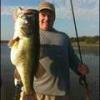I have caught fish bouncing huds on the bottom in 40-50ft of water and they don't float in the live well. When these fish are hooked they generally shoot to the surface in a matter of seconds like a torpedo. So my question is do smaller fish take more time to adjust than bigger fish? I have found that fish which voluntarily come up in many cases have adjusted. And if they can adjust in a matter of seconds could they comfortably adjust over the course of an hour? What depth change requires major adjustment? Can a fish move from 3' of water to say 15' without major a adjustment? Most fish I have caught in 15' of water do not need to be fizzed when brought up. A lot of the water I fish is pretty deep and clear. When they are up shallow fish are pretty easy to spot. There is very little cover for these fish to relate to. If they stay the same depth suspended as they do up shallow why don't I see more fish roaming over deeper water?
Really good observations and questions. I'll offer my understanding at this point:
It's not definitively known how rapidly bass can adjust to depth change. The best educated guesses so far (based on studies on other physoclistus -closed bladder- fishes) is that bladder adjustment is about a foot or two per hour -if they decide to make such a change. It may be energetically costly to do so, so it appears most bass do not do this often.
From angler observations via sonar, bass may make moves of 15feet quickly, say to smack a bait, but must return to acclimation depth soon. Short term changes of less than 10 feet are known for feeding bouts, but this would not be comfortable or energy efficient for a prolonged period. I've watched shallow buoyant hunters (I can see them finning to maintain position) drop out of sight, making a roughly 4foot depth change into cover, or into the gloom of depth. These were LM. From studies and angler observations, SM and SP appear to have more leeway in depth change than LM.
As to why you don't see suspended bass: Bass do not often like to be visible from the surface. When you see them they are either spawning, sunning (at times, but usually close to cover), or briefly exposed while feeding. When they were feeding up in the water column they were likely positively buoyant, afterwards dropping a bit deeper and becoming neutral again. It doesn't take much depth change to allow a bass to "disappear". They appear smaller with each inch of depth gain. And they are very well camouflaged. Amazes me how easily they can disappear when they want to.
As to 50ft catches that come shallow that don't float in the live-well. From what I understand at this point, that shouldn't be possible. Maybe large bass are more capable in this regard than is known, and those in your water's regularly make good use of this. I read one study in which yellow perch (physoclists) made nightly changes of 20feet. If the payoff can counter the effort/energy deficit, maybe it's possible. But another explanation might be the way sonar depicts discrete objects like fish. They are recorded on screen in relation to the distance from the transducer not necessarily their depth. A big hook at 50 feet might be 50 feet from the TD, but only 20feet deep, or much less.
Just to add to Pauls great answer bass do have a way to compress the bladder to move deeper but it also causes them to sink so they would have to swim to stay off the bottom. All they have to do is swim downward against the bladders floatation until buoyancy is lost. I personally don't fizz fish but send them down with a weight until they sink which is the same thing as the bass swimming down. Also ultra deep fish from my own experience can and will make larger moves than fish in shallow water. The pressure must change much slower in ultra deep water. Also, the balance of a fish is connected to it's swim bladder so "not needing to be fizzed" and having a good balance and equilibrium to live and feed are not always the same thing.











